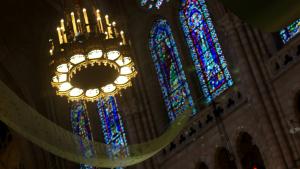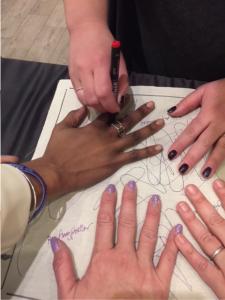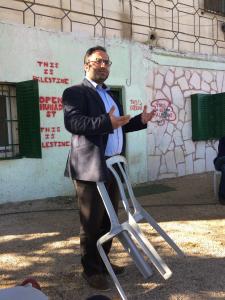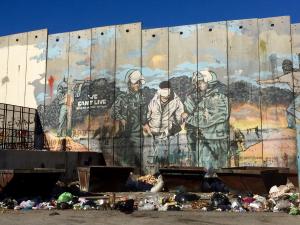I first became aware of the poem about 10 years ago.
It was painted, lettered by hand, on a white  cinderblock wall on Simon Bolivar Avenue in New Orleans. I drove past the wall every morning on my way to work at a large downtown homeless shelter where I ran a program for women.
cinderblock wall on Simon Bolivar Avenue in New Orleans. I drove past the wall every morning on my way to work at a large downtown homeless shelter where I ran a program for women.
It always seemed a little curious to me that these words were painted on a wall bordering an empty parking lot, littered with trash, frequented by homeless folk and drug dealers, in the middle of a neighborhood totally blighted and depressed:
“You may write me down in history
With your bitter, twisted lies,
You may trod me in the very dirt
But still, like dust, I’ll rise.”
I think it is safe to say I never imagined, as I drove by that wall every morning, the different perspective I would come to have on Maya Angelou’s magnificent poem, how faith and justice-making would intersect my life again far from a desperate neighborhood of inner city New Orleans.
It happened a few weeks before Christmas when Terry Lynch, director of the Downtown Cluster of Congregations, called to ask me if I might be available to participate in a prayer service ushering in the new administration of D.C. Mayor, Adrian Fenty. 
Terry explained that, while most clergy participating would be offering prayers as part of the service, he specifically wanted me to read “Still I Rise”, the Maya Angelou poem I knew from the wall near the Mission in New Orleans.
It wasn’t until I started looking closely at the poem that I started to get a little worried.
First of all, the poem is definitely about the struggle African Americans face, primarily African American women, in overcoming racism, classism, and sexism in this country.
Small matter to note: I am not a Black woman.
Further, in articulating the frustration of oppression, Maya Angelou uses some powerful language and provocative images. Could I pull it off? From the pulpit at New York Avenue Presbyterian Church??!?! The same pulpit from which PETER MARSHALL preached?
(Deep breaths.)
Thanks to the encouragement of professional actor and co-director of the Washington Theatre Lab, Deb Gottesman, I decided to tackle the poem head on. As she made me practice (and practice and practice) I gradually began to read and say the words of that poem in a totally new way.
In other words, the beautiful images and heartfelt expressions of the words began to plant themselves in my own heart, to become more than just a mural on a wall standing in curiously sharp contrast to the desperate context in which it was painted.
Despite my determination and new appreciation for the poem, I realized on January 2, when I lined up with 8 other area clergy to process into the service that I still didn’t have a full understanding of the pomp and circumstance that reigns in this city. So much media . . . myriad of security officers . . . public personalities milling around . . . I was overwhelmed.
But once you’re up there it’s hard to leave.
When my turn came I walked up and recited the poem as Deb and I had practiced. As I finished up the poem, I felt the power of Maya Angelou’s words rising above all the political trappings of the moment and really, powerfully, embodying the hopes we shared for the future of our city in that moment:
“Out of the huts of history’s shame
I rise
Up from a past that’s rooted in pain
I rise
I’m a black ocean, leaping and wide,
Welling and swelling I bear in the tide.
Leaving behind nights of terror and fear
I rise
Into a daybreak that’s wondrously clear
I rise
Bringing the gifts that my ancestors gave,
I am the dream and the hope of the slave.
I rise
I rise
I rise.”
 It was nerve-wracking, yes. But I’ve started to see the experience as one of coming full circle. From a crumbling wall painted with these words in defiance to a neighborhood of squalor . . . all the way to the excited report of a Calvary teen: “I saw Pastor Amy reading Maya Angelou’s poem on TV!” . . . this is the power of masterful words to shape our lives and give meaning to the struggle we engage in as human beings walking this earth.
It was nerve-wracking, yes. But I’ve started to see the experience as one of coming full circle. From a crumbling wall painted with these words in defiance to a neighborhood of squalor . . . all the way to the excited report of a Calvary teen: “I saw Pastor Amy reading Maya Angelou’s poem on TV!” . . . this is the power of masterful words to shape our lives and give meaning to the struggle we engage in as human beings walking this earth.
For words that powerfully articulate pain and struggle, while at the same time calling us together to change things . . . for opportunities to notice how these words intersect our lives in powerful ways . . . for life coming full circle, all the way from a struggling neighborhood in New Orleans to City Hall in the capital of the free world . . . for all these things I am so thankful.











